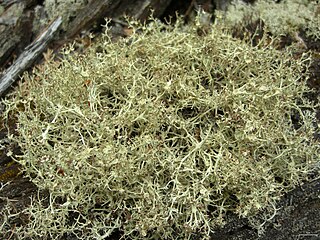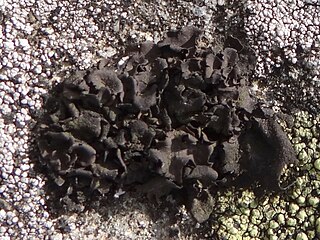
Cladonia is a genus of moss-like lichens in the family Cladoniaceae. They are the primary food source for reindeer/caribou. Cladonia species are of economic importance to reindeer-herders, such as the Sami in Scandinavia or the Nenets in Russia. Antibiotic compounds are extracted from some species to create antibiotic cream. The light green species Cladonia stellaris is used in flower decorations.

Cladonia portentosa, also known as reindeer lichen or the cream cup lichen, is a light-coloured, fruticose, cup lichen in the family Cladoniaceae.

Cladonia fimbriata or the trumpet cup lichen is a species cup lichen belonging to the family Cladoniaceae.

Cladonia parasitica, commonly known as the fence-rail cladonia, fence-rail cup lichen or parasite club lichen, is a species of fruticose, cup lichen in the family Cladoniaceae. It was first described by Hoffmann in 1784 under the name Lichen parasiticus, until he reclassified it under the genus Cladonia in 1795.

Cladonia amaurocraea, commonly known as the quill lichen or the quill cup lichen, is a species of fruticose, cup lichen in the Cladoniaceae family.

Cladonia caespiticia is a widespread and common species of fruticose, cup lichen in the family Cladoniaceae. It was originally named Baeomyces caespiticius by German mycologist Christiaan Hendrik Persoon in 1794. Heinrich Gustav Flörke transferred it to the genus Cladonia in 1827. In North America, it is commonly known as the stubby-stalked Cladonia.

Umbilicaria polyphylla, commonly known as petaled rock tripe, is a widely distributed species of saxicolous lichen in the family Umbilicariaceae. It was first described by Carl Linnaeus in his 1753 work Species Plantarum as Lichen polyphyllus. German botanist Johann Christian Gottlob Baumgarten transferred it to the genus Umbilicaria in 1790. The lichen has a dark brown to black thallus that measures 2–6 cm (0.8–2.4 in) in diameter. The upper surface is smooth, while the lower surface is sooty black. It grows on exposed rocks, typically in arctic-alpine habitats.

Cladonia deformis, also known as the lesser sulphur cup or the lesser sulphur cup lichen, is a light-coloured, fruticose, cup lichen belonging to the family Cladoniaceae. This lichen was first described as Lichen deformis by Carl Linnaeus in 1753, and transferred to the genus Cladonia in 1796 by Georg Franz Hoffmann.

Cladonia digitata, commonly known as the finger cup lichen, is a cup lichen species in the family Cladoniaceae.

Cladonia gracilis or the smooth cup lichen is a species of fruticose, cup lichen in the family Cladoniaceae. It was first described as a new species by Carl Linnaeus in his 1753 work Species Plantarum. German botanist Carl Ludwig Willdenow transferred it to the genus Cladonia in 1787. In North America, it is known colloquially as the "smooth Cladonia".

Cladonia subulata is a species of fruticose, cup lichen in the family Cladoniaceae. It was first described as a new species by Swedish taxonomist Carl Linnaeus in 1753. It was transferred to the genus Cladonia by Friedrich Heinrich Wiggers in 1780. In North America, the lichen is colloquially known as the antlered powderhorn or antlered cup lichen.

Cladonia uncialis is a species of fruticose, cup lichen in the family Cladoniaceae. It was first described as a new species by Swedish taxonomist Carl Linnaeus in 1753. It was transferred to the genus Cladonia by Friedrich Heinrich Wiggers in 1780. In North America, the lichen is colloquially known as the thorn Cladonia or the thorn cup lichen.

Cladonia glauca or the glaucous cup lichen is a species of fruticose, cup lichen in the family Cladoniaceae. Found in Europe, it was formally described as a new species in 1828 by German botanist Heinrich Gustav Flörke. The nematodes Aphelenchoides lichenicola and Ottolenchus cabi feed on this lichen.

Cladonia incrassata or the powder-foot British soldiers cup lichen is a species of cup lichen in the family Cladoniaceae. Found in Europe and North America, it was formally described as a new species in 1828 by German botanist Heinrich Gustav Flörke. A colloquial name for the lichen is "powder-foot British soldiers".

Cladonia pleurota is a species of fruticose, cup lichen in the family Cladoniaceae. It was first formally described as a new species by German lichenologist Heinrich Gustav Flörke in 1808 as Capitularia pleurota. Ludwig Emanuel Schaerer transferred it to the genus Cladonia in 1850. In North America, it is known colloquially as the red-fruited pixie cup or the red-fruited cup lichen.

Cladonia macilenta or the lipstick cup lichen is a species of cup lichen in the family Cladoniaceae.

Cladonia strepsilis or the olive cup lichen is a species of cup lichen in the family Cladoniaceae. In Iceland, where it is only found in a few locations in the Eastern Region, it is red listed as endangered (EN).

Cladonia sulphurina is a species of cup lichen belonging to the family Cladoniaceae.
Cladonia homosekikaica is a species of cup lichen belonging to the family Cladoniaceae. It was formally described as a new species by Japanese lichenologist Mariko Nuno in 1975.


















